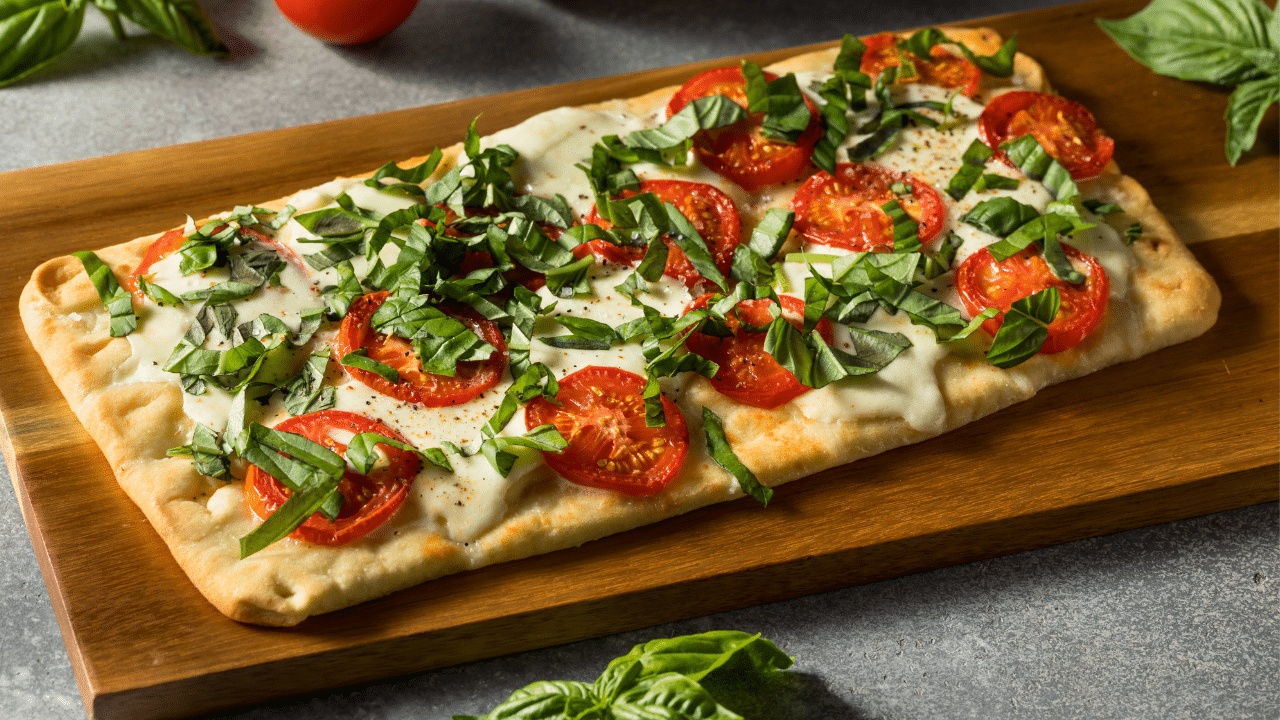
How to Make a Delicious and Nutritious Healthy Pizza at Home
Key Elements of a Healthy Pizza
Creating a nutritious pizza starts with understanding which components you can modify to boost nutrition without sacrificing flavor. Let’s break down the essential elements of a healthy pizza:
Nutritious Crust Alternatives
The foundation of any pizza is its crust, which traditionally accounts for most of the calories and refined carbohydrates. Consider these healthier alternatives:
- Whole Wheat Crust: Higher in fiber and nutrients than white flour, providing longer-lasting energy.
- Cauliflower Crust: Low-carb option that’s perfect for keto diets and adds extra vegetables to your meal.
- Chickpea Flour Crust: Adds protein and fiber while offering a naturally gluten-free option.
- Spelt Flour Crust: Ancient grain option that many find easier to digest than modern wheat.

Smarter Sauce Options
Traditional pizza sauce can be high in sodium and added sugars. Try these healthier alternatives:
- Homemade Tomato Sauce: Control the ingredients by making your own with fresh tomatoes, garlic, and herbs.
- Pesto: Made with basil, olive oil, and pine nuts for healthy fats and flavor.
- Hummus: Creates a creamy base while adding protein and fiber.
- Olive Oil and Garlic: A simple, light base that lets toppings shine.
Lighter Cheese Options
Cheese is typically the highest source of fat and calories on a pizza. Consider these modifications:
- Part-Skim Mozzarella: Lower in fat while still providing that classic stretch.
- Goat Cheese: Tangy flavor means you can use less while still getting great taste.
- Nutritional Yeast: Plant-based option that adds a cheesy flavor for vegans.
- Use Less, But Better Quality: A small amount of flavorful cheese goes further than a lot of mild cheese.
Nutrient-Dense Toppings
Load up on vegetables and lean proteins to create a balanced meal:
- Colorful Vegetables: Bell peppers, spinach, arugula, mushrooms, tomatoes, and onions.
- Lean Proteins: Grilled chicken, turkey pepperoni, or plant-based options like tempeh.
- Healthy Fats: Olives, avocado slices, or a light drizzle of olive oil.
- Fresh Herbs: Basil, oregano, or rosemary add flavor without calories.

Step-by-Step Healthy Pizza Recipe
Now that you understand the components of a healthy pizza, let’s put it all together with this customizable recipe that serves 4 people.

For the Whole Wheat Crust:
- 1 cup whole wheat flour
- 1 cup all-purpose flour (or additional whole wheat for extra fiber)
- 1 packet (2¼ tsp) active dry yeast
- 1 teaspoon honey or maple syrup
- 1 teaspoon salt
- 1 tablespoon olive oil
- ¾ cup warm water (about 110°F)
For the Sauce:
- 1 cup crushed tomatoes (no added salt or sugar)
- 2 cloves garlic, minced
- 1 tablespoon olive oil
- 1 teaspoon dried oregano
- 1 teaspoon dried basil (or 1 tablespoon fresh)
- Pinch of red pepper flakes (optional)
For the Toppings:
- 1 cup part-skim mozzarella cheese, shredded
- 1 cup shredded or diced cooked chicken breast
- 1 bell pepper, thinly sliced
- ½ red onion, thinly sliced
- 1 cup mushrooms, sliced
- 1 cup fresh spinach or arugula
- Fresh basil leaves for garnish
Ready to Start Cooking?
Jump straight to the instructions or print this recipe for your kitchen!
Instructions:
- Prepare the dough: In a large bowl, combine the flours, yeast, and salt. In a separate small bowl, mix warm water with honey and olive oil. Pour the liquid mixture into the dry ingredients and stir until a dough forms.
- Knead the dough: Turn the dough onto a floured surface and knead for 5-7 minutes until smooth and elastic. Form into a ball.
- Let it rise: Place the dough in an oiled bowl, cover with a damp cloth, and let rise in a warm place for 45-60 minutes until doubled in size.
- Prepare the sauce: While the dough rises, mix all sauce ingredients in a small saucepan. Simmer on low heat for 10 minutes, then set aside to cool.
- Preheat the oven: Set your oven to 450°F (230°C) and if you have one, place a pizza stone inside to heat up.
- Shape the dough: Once risen, punch down the dough and roll it out on a floured surface to your desired thickness. For extra thin crust, divide the dough in half and make two pizzas.
- Assemble the pizza: Transfer the dough to a parchment-lined baking sheet or pizza peel. Spread the sauce evenly, leaving a small border for the crust. Add cheese and toppings.
- Bake: Bake for 12-15 minutes until the crust is golden and the cheese is bubbly.
- Finish: Remove from oven, top with fresh arugula or basil if desired, slice, and enjoy!

Nutritional Benefits of Healthy Pizza
Understanding the nutritional improvements in your homemade healthy pizza can help you appreciate just how much better it is than traditional delivery options.
| Nutritional Element | Traditional Delivery Pizza (1 slice) | Healthy Homemade Pizza (1 slice) | Benefits |
| Calories | 300-400 | 200-250 | Lower calorie content supports weight management |
| Fat | 10-15g | 5-8g | Reduced saturated fat improves heart health |
| Sodium | 600-900mg | 300-400mg | Lower sodium supports healthy blood pressure |
| Fiber | 1-2g | 3-5g | Higher fiber improves digestion and satiety |
| Protein | 12-15g | 15-20g | More protein supports muscle maintenance |

Beyond the numbers, homemade healthy pizza offers additional benefits:
- Control over ingredients: Avoid preservatives, excess sodium, and hidden sugars found in commercial pizzas.
- Higher vitamin and mineral content: Fresh vegetables provide essential nutrients like vitamins A, C, and K.
- Better quality fats: Olive oil and avocado provide heart-healthy monounsaturated fats.
- Portion control: Make appropriately sized pizzas rather than being tempted by extra-large delivery options.
Tips for Customizing Your Healthy Pizza
One of the best things about making pizza at home is the ability to customize it for different dietary needs and preferences. Here are some suggestions for adapting your healthy pizza:
Gluten-Free Options
- Cauliflower crust (pre-made or homemade)
- Chickpea flour crust
- Commercial gluten-free pizza dough
- Portobello mushroom caps as mini pizza bases
Vegan Adaptations
- Plant-based cheese alternatives or nutritional yeast
- Cashew cream sauce base
- Protein-rich toppings like tempeh or tofu
- Avocado slices added after baking
Keto-Friendly Ideas
- Fathead dough (made with cheese and almond flour)
- Chicken crust (ground chicken mixed with cheese)
- Extra cheese instead of high-carb toppings
- Low-carb vegetables like spinach and mushrooms
Share Your Healthy Pizza Creation!
Made your own version? We’d love to see it! Tag us on social media with #HealthyPizzaCreation
Expert Tips for Perfect Healthy Pizza
Take your healthy pizza to the next level with these professional tips:
Preparation Tips
- Preheat properly: Make sure your oven is fully preheated to at least 450°F (230°C) for a crispy crust.
- Use a pizza stone: If available, a pizza stone creates a crispier crust by absorbing moisture.
- Par-bake the crust: For very wet toppings, bake the crust for 3-5 minutes before adding toppings.
- Drain wet ingredients: Remove excess moisture from vegetables like zucchini or tomatoes to prevent a soggy crust.
Flavor Boosters
- Finish with fresh herbs: Add basil, arugula, or other fresh herbs after baking for brightness.
- Try a balsamic drizzle: A light drizzle of balsamic glaze adds sweetness and acidity.
- Roast your vegetables: Pre-roasting vegetables intensifies their flavor before adding to pizza.
- Don’t forget the salt: A light sprinkle of flaky sea salt just before serving enhances all flavors.
Conclusion: Enjoy Pizza Night Without the Guilt
Creating a healthy pizza at home doesn’t mean sacrificing flavor or satisfaction. By making thoughtful choices about your crust, sauce, cheese, and toppings, you can transform a traditionally indulgent meal into a nutritious option that supports your wellness goals.
Remember that balance is key – it’s perfectly fine to enjoy a traditional pizza occasionally as part of a varied diet. But for those regular pizza nights, these healthier alternatives allow you to indulge more frequently without compromising your health objectives.
We encourage you to experiment with different combinations of the ingredients and techniques we’ve shared. Your perfect healthy pizza is waiting to be created in your kitchen!
Ready to Make Your Own Healthy Pizza?
Save this recipe and start creating your own nutritious pizza masterpiece tonight!
Did you try this recipe?
We’d love to hear how your healthy pizza turned out! Leave a comment below and share your experience or any creative variations you tried.


